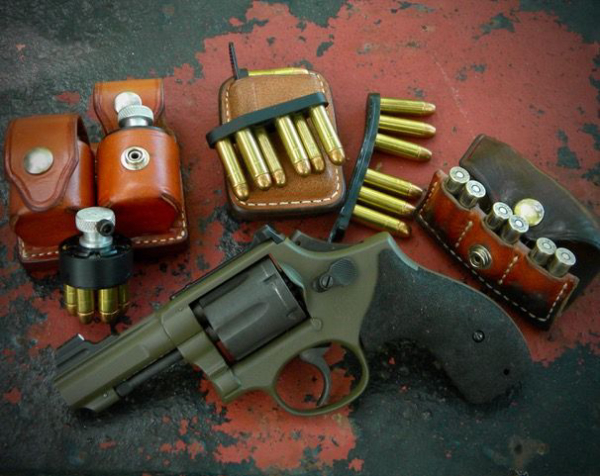
Revolvers are “big” these days. For those who have always used and carried wheel guns it’s a great time. There are more revolver offerings now than ever before; quality guns in a variety of calibers. This golden age is also attractive to new shooters as well. One thing that old and new shooters both need to think about is carrying extra ammo. There are several great ways of carrying ammo to try, plus a healthy dose of personal choice to consider before choosing “your” way.
“I just dump a handful of bullets in my pocket” – some say. I’m pretty sure this is the least desirable way to carry the ammunition that your life might depend on. I don’t know about you, but emptying my pockets at the end of the day always reveals strange, foreign matter and I have no idea where it all came from, much less found its way into my pockets. A little bit of this clinging to your ammo goes a long way towards creating a stoppage or jam when it’s loaded into the cylinder. Pants pockets, especially the fronts, are difficult if not impossible to get to unless you’re standing. I teach students to use speed loaders, speed strips and “pick-pouches.”
Most people are familiar with or have seen speed loaders. Loaders hold the rounds in position, ready to feed into the cylinder. Index the rounds into the cylinder, then push or twist – depending on what type loaders being used – and release the rounds. Moon clips work on the same principle. Dump the empty clip holding the cases and load the cylinder with another clip. While loaders and clips are the most efficient way to reload an empty revolver, it’s also an all or nothing option. You unload and load completely, even though the cylinder may still contain live rounds. There’s no way to load one or two rounds as they’re fired.
Speed strips do let you load individual rounds as required. These rubber strips – although they now come in a variety of shapes - hold five, six, seven or more rounds depending on the design. You insert a round, or two or maybe three depending on the design of the strip, then bend and pull the strip to release the rounds. This allows you to load individual rounds as required, obviously when you have the opportunity, without having to dump live ammo. Strips are carried in pouches, which are easily concealed.
I regularly use pouches, but “pick-pouches,” or what are called “3x2” pouches. Think of these as a belt loop that holds ammo, but with three compartments that hold two rounds each and covered by a flap. When you pull it open the flap holding the rounds drops down so you can easily acquire the rounds. With practice it’s easy to pull out two rounds at a time to load. (The pouch you want has an extra piece of leather on the flap that prevents it from flopping completely and dumping your ammo on the ground.). These pouches are easy to conceal; even when someone sees one, they don’t have a clue what it is. And, like the speed strips, you can load rounds as required.
To manipulate the revolver, you can keep it in the strong hand, or switch it over to the support hand. Both methods are acceptable. Once you’ve determined how you’re going to manipulate the pistol you can determine how and where you’ll carry it. Some find it more efficient to maintain their firing grip and manipulate using the support hand. For those whose strong hand is more dexterous, it works best for the fine motor skills required, holding the pistol in the support hand during manipulations works best. Others will alternate hands, depending on what type manipulation they’re performing. You have to experiment to determine which works best, just make sure to not give up on one way or the other until giving all options an equal opportunity. Once you decide which hand does what, it’s time to choose where to carry spare ammo.
At first glance revolvers look “easy,” but nothing about them is as simple as it seems. Wheel guns take a lot more practice to master than semi-autos, both in marksmanship and manipulations – especially manipulations. There are multiple ways to manipulate the weapon, and even more ways to carry spare ammo. However, they are great for self-defense. As long as you put in the time required to become proficient with them, revolvers are very rewarding – in every way.
Tiger McKee is director of Shootrite Firearms Academy. He is the author of The Book of Two Guns, AR-15 Skills and Drills, has a regular column in American Handgunner and makes some cool knives and custom revolvers. Visit Shootrite’s Facebook page for other details.
